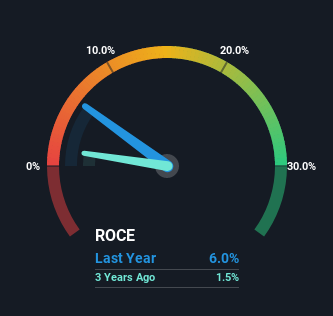[ad_1]
What financial metrics can indicate to us that a company is maturing or even in decline? A business that’s potentially in decline often shows two trends, a return on capital employed (ROCE) that’s declining, and a base of capital employed that’s also declining. Basically the company is earning less on its investments and it is also reducing its total assets. In light of that, from a first glance at Universal Electronics (NASDAQ:UEIC), we’ve spotted some signs that it could be struggling, so let’s investigate.
Understanding Return On Capital Employed (ROCE)
For those that aren’t sure what ROCE is, it measures the amount of pre-tax profits a company can generate from the capital employed in its business. Analysts use this formula to calculate it for Universal Electronics:
Return on Capital Employed = Earnings Before Interest and Tax (EBIT) ÷ (Total Assets – Current Liabilities)
0.06 = US$17m ÷ (US$525m – US$236m) (Based on the trailing twelve months to March 2022).
Therefore, Universal Electronics has an ROCE of 6.0%. Ultimately, that’s a low return and it under-performs the Consumer Durables industry average of 16%.
Check out our latest analysis for Universal Electronics

In the above chart we have measured Universal Electronics’ prior ROCE against its prior performance, but the future is arguably more important. If you’d like to see what analysts are forecasting going forward, you should check out our free report for Universal Electronics.
So How Is Universal Electronics’ ROCE Trending?
There is reason to be cautious about Universal Electronics, given the returns are trending downwards. Unfortunately the returns on capital have diminished from the 10% that they were earning five years ago. Meanwhile, capital employed in the business has stayed roughly the flat over the period. Companies that exhibit these attributes tend to not be shrinking, but they can be mature and facing pressure on their margins from competition. If these trends continue, we wouldn’t expect Universal Electronics to turn into a multi-bagger.
On a separate but related note, it’s important to know that Universal Electronics has a current liabilities to total assets ratio of 45%, which we’d consider pretty high. This effectively means that suppliers (or short-term creditors) are funding a large portion of the business, so just be aware that this can introduce some elements of risk. Ideally we’d like to see this reduce as that would mean fewer obligations bearing risks.
In Conclusion…
In the end, the trend of lower returns on the same amount of capital isn’t typically an indication that we’re looking at a growth stock. Long term shareholders who’ve owned the stock over the last five years have experienced a 61% depreciation in their investment, so it appears the market might not like these trends either. Unless there is a shift to a more positive trajectory in these metrics, we would look elsewhere.
If you want to continue researching Universal Electronics, you might be interested to know about the 1 warning sign that our analysis has discovered.
While Universal Electronics may not currently earn the highest returns, we’ve compiled a list of companies that currently earn more than 25% return on equity. Check out this free list here.
Have feedback on this article? Concerned about the content? Get in touch with us directly. Alternatively, email editorial-team (at) simplywallst.com.
This article by Simply Wall St is general in nature. We provide commentary based on historical data and analyst forecasts only using an unbiased methodology and our articles are not intended to be financial advice. It does not constitute a recommendation to buy or sell any stock, and does not take account of your objectives, or your financial situation. We aim to bring you long-term focused analysis driven by fundamental data. Note that our analysis may not factor in the latest price-sensitive company announcements or qualitative material. Simply Wall St has no position in any stocks mentioned.
[ad_2]
Source link








